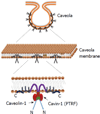Caveolae, caveolin-1 and cavin-1: Emerging roles in pulmonary hypertension
- PMID: 28529892
- PMCID: PMC5438095
- DOI: 10.5320/wjr.v5.i2.126
Caveolae, caveolin-1 and cavin-1: Emerging roles in pulmonary hypertension
Abstract
Caveolae are flask-shaped invaginations of cell membrane that play a significant structural and functional role. Caveolae harbor a variety of signaling molecules and serve to receive, concentrate and transmit extracellular signals across the membrane. Caveolins are the main structural proteins residing in the caveolae. Caveolins and another category of newly identified caveolae regulatory proteins, named cavins, are not only responsible for caveolae formation, but also interact with signaling complexes in the caveolae and regulate transmission of signals across the membrane. In the lung, two of the three caveolin isoforms, i.e., cav-1 and -2, are expressed ubiquitously. Cavin protein family is composed of four proteins, named cavin-1 (or PTRF for polymerase Ⅰ and transcript release factor), cavin-2 (or SDPR for serum deprivation protein response), cavin-3 (or SRBC for sdr-related gene product that binds to-c-kinase) and cavin-4 (or MURC for muscle restricted coiled-coiled protein or cavin-4). All the caveolin and cavin proteins are essential regulators for caveolae dynamics. Recently, emerging evidence suggest that caveolae and its associated proteins play crucial roles in development and progression of pulmonary hypertension. The focus of this review is to outline and discuss the contrast in alteration of cav-1 (cav-1),-2 and cavin-1 (PTRF) expression and downstream signaling mechanisms between human and experimental models of pulmonary hypertension.
Keywords: Caveolae; Caveolin-1; Cavin-1; Lipid rafts; Pulmonary hypertension.
Conflict of interest statement
Conflict-of-interest statement: All the authors have no conflict of interests.
Figures



Similar articles
-
MURC/Cavin-4 and cavin family members form tissue-specific caveolar complexes.J Cell Biol. 2009 Jun 29;185(7):1259-73. doi: 10.1083/jcb.200903053. Epub 2009 Jun 22. J Cell Biol. 2009. PMID: 19546242 Free PMC article.
-
Cavin Family: New Players in the Biology of Caveolae.Int Rev Cell Mol Biol. 2015;320:235-305. doi: 10.1016/bs.ircmb.2015.07.009. Epub 2015 Aug 31. Int Rev Cell Mol Biol. 2015. PMID: 26614875 Review.
-
IGF-IR internalizes with Caveolin-1 and PTRF/Cavin in HaCat cells.PLoS One. 2010 Nov 30;5(11):e14157. doi: 10.1371/journal.pone.0014157. PLoS One. 2010. PMID: 21152401 Free PMC article.
-
The coiled-coil domain of MURC/cavin-4 is involved in membrane trafficking of caveolin-3 in cardiomyocytes.Am J Physiol Heart Circ Physiol. 2015 Dec 15;309(12):H2127-36. doi: 10.1152/ajpheart.00446.2015. Epub 2015 Oct 23. Am J Physiol Heart Circ Physiol. 2015. PMID: 26497963
-
Role of Caveolae family-related proteins in the development of breast cancer.Front Mol Biosci. 2023 Sep 27;10:1242426. doi: 10.3389/fmolb.2023.1242426. eCollection 2023. Front Mol Biosci. 2023. PMID: 37828916 Free PMC article. Review.
Cited by
-
The role of transcytosis in the blood-retina barrier: from pathophysiological functions to drug delivery.Front Pharmacol. 2025 Apr 16;16:1565382. doi: 10.3389/fphar.2025.1565382. eCollection 2025. Front Pharmacol. 2025. PMID: 40308764 Free PMC article. Review.
-
Revealing Cavin-2 Gene Function in Lung Based on Multi-Omics Data Analysis Method.Front Cell Dev Biol. 2022 Jan 31;9:827108. doi: 10.3389/fcell.2021.827108. eCollection 2021. Front Cell Dev Biol. 2022. PMID: 35174175 Free PMC article. Review.
-
Exosomal transmission of viruses, a two-edged biological sword.Cell Commun Signal. 2023 Jan 23;21(1):19. doi: 10.1186/s12964-022-01037-5. Cell Commun Signal. 2023. PMID: 36691072 Free PMC article. Review.
-
Caveolae and Lipid Rafts in Endothelium: Valuable Organelles for Multiple Functions.Biomolecules. 2020 Aug 21;10(9):1218. doi: 10.3390/biom10091218. Biomolecules. 2020. PMID: 32825713 Free PMC article. Review.
-
The protective role of EP300 in monocrotaline-induced pulmonary hypertension.Front Cardiovasc Med. 2023 Feb 22;10:1037217. doi: 10.3389/fcvm.2023.1037217. eCollection 2023. Front Cardiovasc Med. 2023. PMID: 36910531 Free PMC article.
References
-
- Boscher C, Nabi IR. Caveolin-1: role in cell signaling. Adv Exp Med Biol. 2012;729:29–50. PMID: 22411312. - PubMed
-
- Cohen AW, Hnasko R, Schubert W, Lisanti MP. Role of caveolae and caveolins in health and disease. Physiol Rev. 2004;84:1341–1379. PMID: 15383654. - PubMed
-
- Loscalzo J. Endothelial dysfunction in pulmonary hypertension. N Engl J Med. 1992;327:117–119. PMID: 1603118. - PubMed
Grants and funding
LinkOut - more resources
Full Text Sources
Other Literature Sources
Miscellaneous
